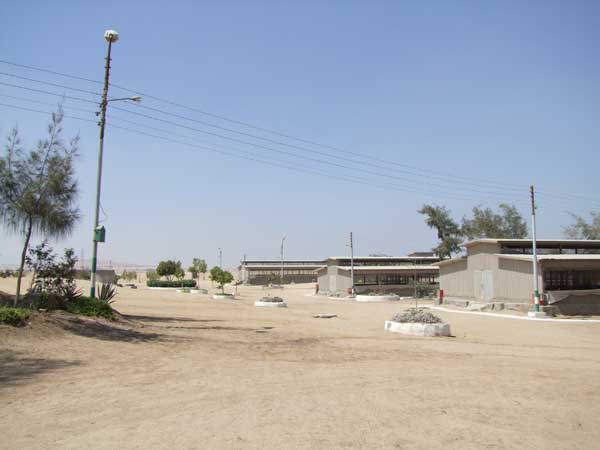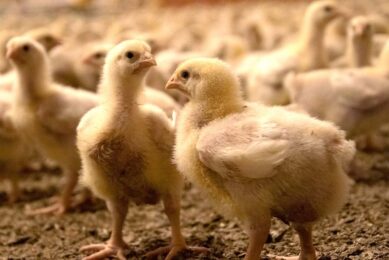Poultry feeding under heat stress conditions

High ambient temperature and humidity adversely affects poultry production. The poultry producer can do much to positively influence bird performance during heat stress through a combination of proper feeding strategies.
By Dr Salah H. Esmail, Cairo, Egypt
Timing of feeding is an important factor in alleviating heat stress effects on feed intake and utilisation. Therefore, the major part of the diet should be made accessible to the birds at times of relatively low temperature (early morning and late evening) with the remaining part thereof to be made available all the time. Broiler chickens appear to be more responsive to the timing of feeding than laying hens. In most cases, the proper timing of feeding could by itself alleviate many of the problems associated with heat stress in broilers, but have not been an adequate measure for layers. It is, therefore, suggested that other feed management factors should also be considered in this latter case for better laying performance. For example, feed should always be fresh and not be stored for longer than two months, especially in summer to reduce the possibility of mycotoxin build up. Further, feed should be properly processed (crumb, pellets, or mash), with extra feeders to be provided in order to encourage appetite on hot days. It might also be benefi cial to dim the lights while feeding, in order to reduce activity and hence minimise heat load on the birds.
Feed form
Offering pelleted feed to broilers can result in a 67% reduction in the energy required for eating, and hence direct such an amount of energy towards productive purposes. Because the physical nature of the pellets allows the birds to consume their feed with less wasted energy, the quality and durability of the pellets is particularly important. A change of 10% in fines may result in a change of 0.01 in feed conversion ratio. At high temperature, there should be an advantage in providing broilers with high quality pellets with the minimum amount of fines, thereby reducing the proportion of energy wasted in acquiring feed.
Dietary protein
In the past, it was usually recommended that dietary protein level be increased in order to maintain constant protein intake under heat stress when feed consumption is reduced. Over the years, however, more evidence exists to show that protein requirements of heat-stressed birds may not necessarily be increased. In one study, increasing protein concentration from 17% to 23% did not improve growth of chickens kept between 3-6 weeks of age under high temperature (32ºC). This was attributed mainly to the increased N excretion and reduced efficiency of the high-protein diet compared to the lowprotein diet (Table 1). Protein utilisation is usually better in birds fed low-protein diets, and this fact might be a metabolism adjustment in order to use protein better when provided in limited quantity. In some cases, however, the reduced level of dietary protein may be detrimental if no consideration is given to protein quality and its amino acid profile. It was found that with protein sources having methionine and lysine in the exact amount and proportion, it is possible to reduce 2-4% of diet protein without affecting weight gain and feed conversion. The reduction of any amino acid will, on the other hand, cause its own deficiency, and protein will thus become non-ideal regardless of the protein level.
Dietary fat
Inclusion of fats in the diet should be considered on hot days, particularly for broiler chickens, in order to maintain daily energy intake in line with the requirements for growth. On many tropical farms, it is common practice to exclude fat from the diet during summer and include it during winter. It is though, that the energy requirement of broilers is less in summer than in winter. Recent studies, however, have shown that the inclusion of fat in diets for heat-stressed broilers helps improve feed intake and performance, because of the lower heat increment of fat compared to other energy sources such as carbohydrates or proteins. It should be noted though that when the dietary energy density is increased by adding fat, the level of other nutrients, particularly proteins, must be proportionally adjusted to maintain a balanced feed and hence improve utilisation.
Care must also be taken when selecting the fat source to be incorporated into the diet. Generally fat sources having large amounts of polyunsaturated fatty acids, such as soybean oil, canola oil, walnuts, flaxseed oil, and fi sh oil, should all be avoided or be used at minimal levels in the diet. This is due to the fact that such sources have low levels of antioxidants and are especially susceptible to oxidative rancidity and destruction of vitamin A and E, with resulting changes in the flavour of poultry meats. In addition, fat sources high in polyunsaturated fatty acids such as soybean oil often lead to excessive visceral and breast intramuscular fat formation and hence affect carcass quality (Table 2).
Minerals and vitamins
Increased mineral excretion is one of the major consequence of heat stress. Retention rates of phosphorus, potassium, sodium, magnesium, sulphur, manganese, copper, and zinc are all lowered in broilers reared at 35ºC compared to those reared at 24ºC, with a resulting impairment of growth, feed efficiency, and carcass traits. Laying hens reared at such elevated temperature also exhibit increased mineral excretion with a resulting decline of egg weight and eggshell strength. This may force the need for further supplementation of diets with these minerals if better performance is to be achieved for heatstressed broilers and layers.
Requirements for vitamins also increase under heat stress conditions. This could be attributed to physiological factors which reduce vitamin utilisation such as changes in acid-base balance, and poor absorption of vitamins, in addition to the reduced availability of vitamin in feed premixes under high temperature (Table 3). Proper vitamin supplementation and adequate protection of feed against heat are, therefore, needed in this case to improve growth, immunity, egg production, and other biological functions.
Use of cumin seeds
A study was conducted in Egypt to examine growth performance and blood characteristics of broiler chickens receiving diets supplemented with 1% black cumin seeds (Nigella sativa) for seven weeks. This was done during the summer season at temperatures ranging from 31.7ºC to 34.5ºC, with a relative humidity ranging from 47.7% to 57.2%. Results are given in Table 4.
The improved growth of chickens fed on black cumin seeds has been attributed to the increase thyroid hormone concentration which leads to an improved metabolic rate and compensate for the reduced feed intake observed under heat stress. It could also be that the black cumin seeds contain components such as thymoquinones and thymohydroquinones which possess anti-bacterial, anti-fungal, and pharmaceutical activities against liver toxicity and hence improve feed utilisation and growth rate. Further, the feeding of diets supplemented with black cumin seeds may increase bile fl ow which plays an important role in digestion and absorption of fats and fat-soluble vitamins through activation of pancreatic lipase and hence improves performance. The improved blood profi les with black cumin seeds is probably related to the fact that black cumin has increased amounts of unsaturated fatty acids such as oleic, linoleic, and linoleic acids all of which reduce blood cholesterol and triglycerides, in addition to their essential role as growth stimulants. Further, the black cumin seeds contain a number of macro – and micro – minerals which are responsible for the formation of blood haemoglobin. The seeds also contain specific and non-specific factors contributing to the increased number of blood cells, and hence act as immune stimulants and reduce mortality.
Chinese herbs
Another study was conducted in China to examine the effect of adding 0.8% Chinese herbs on weights of internal organs of broiler chickens kept for eight weeks during the summer season where temperature ranges from 29ºC to 35ºC with a relative humidity ranging from 78% to 88%. The herb included rhizomes of marine fl ora, Asian cherry fruit, wild mint, roots of milk vetch, and was supplements with NaHCO3 and KCl.
The use of the Chinese herb resulted in increased weights of stomach, liver, heart, lung, and kidney compared to the control group receiving basal diets without herbal supplement (Table 5). Further, histological examination of these organs revealed that the control group of chickens exposed to heat stress without additives have developed gastric oedema, hepatic lesions and haemorrhage, congestion of heat muscle fi bres and dilation of cardiac veins and arteries, damages of capillaries of the lung and rupture of the lung alveoli due to rapid respiration, and hypertrophy in the renal tubes and epithelial cells. These effects were all much alleviated in the other group of chickens receiving the Chinese herbs in their basal diet. The benefi cial results of using the Chinese herbs in the chicken diets have been attributed here to the eff ects of these herbs on activation of blood circulation and renewal rate, prevention of blood stagnation, reducing oxidation and decomposition of protein, enhancing metabolism of feed nutrients, and cooling of blood with resulting decreases in heat load and respiration rate. It was thus concluded that the use of such herbs under heat stress conditions could be a better alternative to the use of synthetic drugs and antibiotics to which chickens may rapidly develop resistance, in addition to the fact that most of them produce drug residues and cause harm to humans.
Water supply
Heat-stressed birds can dissipate over 80% of their heat production via evaporative cooling. The evaporative heat dissipation extent and calories dissipated per breath are correlated with water consumption level and balance. With reduced water temperature, water consumption would be encouraged, thereby increasing evaporative cooling and heat dissipated per breath. Studies have shown that increasing water consumption by 20% over the basal level can increase heat loss per breath by as much as 30%, with a resulting improvement in performance (Table 6). The improved performance in this case could be attributed mainly to the increased feed intake to off set a portion of the hypothermic effect, and partly to the improved wellbeing of heat-stressed birds.
Water consumption could also be increased by using water troughs in place of nipple or bell-type drinkers, at least during the hot season. With such a system birds would not only be allowed to get enough water, but would also have the chance to submerge their heads and combs in water and hence reduce the heat load by evaporation of water from these body parts.
Join 31,000+ subscribers
Subscribe to our newsletter to stay updated about all the need-to-know content in the poultry sector, three times a week. Beheer
Beheer








 WP Admin
WP Admin  Bewerk bericht
Bewerk bericht